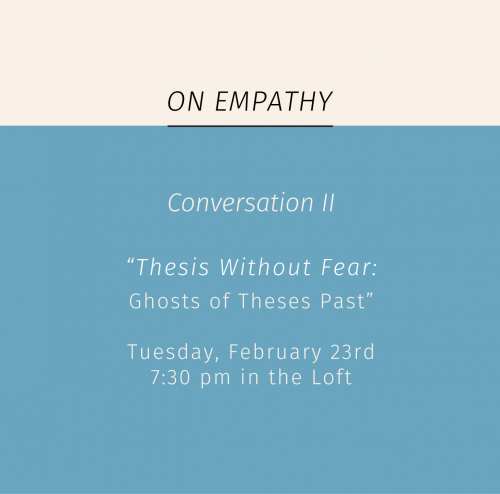Last February, as part of our ongoing On Empathy series of conversations and informal lectures, we held a discussion called “Thesis Without Fear: Ghosts of Theses Past.” The goal was to talk about what it might mean to pursue a ‘fearless’ thesis in the MArch program at UWSA. Our guests Donald McKay, Jonathan Tyrrell, Reza Nik, and Melissa Shea presented some thoughts and took questions, and the resulting discussion was so helpful that I want to share it with incoming grad students this fall. So: gather round! I hope to present the transcript in several installments. Get ready for round 1: Donald McKay’s opening statements, transcribed and edited with his permission.

Event poster from February’s event.
“You can do damn near anything; you just have to understand how to make a book out of it.”
Donald McKay: There seems to be four or five ways of doing this. I don’t think it’s just fearlessness at all; not fearlessness as much as a simple confidence in how you’re operating. Whenever you discuss architecture, you have to look at it as a discourse or a conversation, on one hand, and as a kind of apparatus on the other. And all the time, in our conversations here, the two get confused. When you join this school, and we say you’re now part of the architectural discourse, part of the conversation, your voice is now in play, that’s an absolutely honest fact. But when you go out on a co-op job and you walk into an office, your voice doesn’t have nearly the same effect; you’ve actually joined the professional apparatus. And one of the most important things about any apparatus is that it goes looking for something to do. An apparatus has an unbridled appetite: the law will find crimes, lawyers will find disputes, architects will go find stuff to make. Whereas the discourse, as a conversation, is sometimes more aggressive, sometimes a lot less, sometimes more purposeless – less preoccupied with the outcome than it is with the flavour of the moment or the sense of play.
And I think when you do a thesis you actually address both discourse and apparatus, but over-and-over-again, you’re blind to the power of the apparatus. In this case the apparatus is not the practice of architecture; the apparatus is embodied in the fact that, in this particular school, your thesis is not a thesis until it finds itself being published, until it finds itself in a particular form, until it finds itself in a book. The thesis can be – depending on what faculty member you talk to here – an idea or an argument or some things you make or a way you act or something you document. That is to say, it can be remarkably conversive, can be incredibly discursive, but the safety net the school has is, inevitably, there’s this format that it has to abide by. Now, the first thing to do is liberate yourself about the format. What happens is everybody (as far as I can see) wallows around doing stuff and worrying about stuff, and that’s important, but the first thought I’ve got is, “What kind of books do you like?” What kind of book do you actually see your thesis in? What glimmer of a book do you have in your mind that the things you’re doing are going to find their way into? Is that book a business plan, or a catalog for an art exhibit, or is that book a travelogue or a novella? Is that a book of poetry, is it a book of photographs? You think about the kind of thing you want to see when you open it, and you’ll actually begin to understand what you can and can’t effectively do right at the beginning.
And that doesn’t mean you can’t do anything; it does mean, though, that you have to be witty about what it is that you’re going to do. If you say, “I’m going to dance a thesis because I sincerely believe that dance is at the heart of architecture; before architecture was ever made solid, we had dance and we understood space that way. So I’m going to dance.” That’s really wonderful –– now find out how to put it in a book. Because you can dance all you want up here [gesturing to the room] for any amount of time, but until it goes between those damned orange covers, it doesn’t happen, it doesn’t become a thesis.
So, on the discursive side, you’re free to do anything, so long as you figure out – or just decide, just don’t worry about it – on the side of the apparatus, to say: “Screw it, my thesis is actually going to be, in a classic sense, choreography. There it is – I’m just going to do page after page after page of choreography, and I’m going to have a discussion about how choreography defines space, in the abstract sense. That, in fact, it’s a mapping system.” And then everybody will go “Ooh, cool, maps,” and that’ll be a thesis. But what you did was you danced.
I think the trick to actually doing this in some ‘fearless’ way is to say, you can do anything, but your “get out of jail free card” is your decision about what kind of creature that thesis book finally is – what the genre is. And If you say the genre’s a hybrid, and it’s going to be a novel of photographs, or it’s going to be a documentary as a novella, or it’s going to be a book of prose poems, and you’re asked, “What’s that like?” you say, “Well, like Invisible Cities.”
Everyone worries about what he or she is able to do. But this is a school of architecture; you can do damn near anything. . . . You just have to understand how to make a book out of it.
Samuel Ganton is a graduate student at the University of Waterloo School of Architecture. His thesis research focuses on designing a thunderstorm observatory on a lake in Venezuela.




Leave a Reply